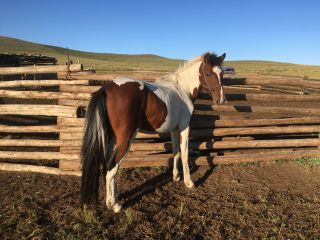Animal Behavior
Why Horses Are Big Dogs
There are unexpected similarities between these two species.
Posted September 29, 2023 Reviewed by Ray Parker
Key points
- A new study finds North American, Indigenous societies used horses much earlier than previously thought,
- There are interesting similarities between horse cognition and dog cognition.
- Horses can discriminate between human facial expressions.

Beside our “best friends,” dogs, perhaps only the horse has had such a profound impact on human history. As a herd animal, horses made life for humans in the harsh steppes of interior Eurasia, or the grasslands of North America, not only possible but highly successful.
As a form of transportation, they changed the way humans communicate, travel, and trade on nearly every continent. For example, the horse is central to many Indigenous cultures across the American Southwest and the Great Plains.
In a recent huge interdisciplinary study, William Taylor and his colleagues have shown that horses rapidly spread from the south into the northern Rockies and central plains by the first half of the 17th century C.E. As reflected in herd management, ceremonial practices, and culture, horses were deeply integrated into Indigenous societies.
Thus, these people used horses much earlier than previously thought–long before the arrival of most 18th- and 19th-century European observers (Taylor et al. 2023).

Interestingly, the words “horse” and “dog” have similar root words in some Indigenous languages in North America. For example, in the Ioway language, a horse is called a “big dog." This illustrates nicely the interesting similarities between both species: Besides their obvious physical and ecological differences.
Domestication has made both species highly successful and widespread all over the world: Dogs and horses are used for many purposes and undergo extensive training in various human cultures. Although horses were domesticated much later than dogs—about 4,000 years ago (Librado et al. 2021)—they have also evolved special skills to communicate with humans.
Horse Cognition
Similar to domestic dogs, horses can use the human pointing gesture to locate hidden food (Proops et al. 2010), they manipulate the attention of a human recipient to obtain unreachable food (Malavasi & Huber, 2016), and solicit help when they cannot solve a problem (Lesimple et al. 2012). Horses can discriminate between positive and negative human facial expressions, can match familiar voices to familiar faces, and are sensitive to human attention (Udell & Brubaker, 2016).
In a recent study, it was shown that horses can differentiate between expressions of joy and sadness displayed by humans through facial movements or voice tones. During this study, the horses were standing in front of two screens, displaying two faces of the same person expressing joy on one screen and sadness on the other screen. Simultaneously, a voice was broadcast, expressing either joy or sadness.
Horses were more attracted by the facial expressions of joy than sadness and seemed more excited by the joyful voices. They were also surprised by the incompatibility of a sad look with a cheerful voice (Jardat et al. 2023).
Why Clever Hans Was Indeed Smart
And then, there is a very old story, the one of "Clever Hans," the horse of Mr. Osten. In the early 20th century, Mr. Osten claimed that his horse could count and calculate numbers. Hans was presented with arithmetic problems, for example, the question: What is 21 divided by 3?
He then answered by tapping on the ground with his hoof, thus he would tap seven times in this case. It seemed to work. When a scientist named Oscar Pfungst investigated this case, he first found out that horse Hans was only successful if the questioner knew the answer himself.
It then turned out that Hans was not able to master mathematics, but he could interpret the finest nuances in the facial expression and body language of the questioner. Involuntarily, people in the audience assumed a tense posture before the decisive "correct" hoof tapping of the horse.
After the correct answer, they unintentionally expressed signals of relief with their body language. Hans perceived that in about 90 percent of all cases and translated it into the desired behavior. The story of “Clever Hans” is usually cited as an example of unconscious curing by humans in a cognitive task (Pfungst, 1965).
However, when you think about it, Hans was indeed a genius, just not a math genius. His special skill was being extremely sensitive towards humans, something we just know from one other species—the dog.
Thus, the link between horses and dogs in Ioway and other Indigenous languages underscores something important. In some way, one can consider the horse as a big dog—at least one of the very few animals that are willing to form a close relationship with us.
References
Brubaker, L., & Udell, M. A. R. (2016). Cognition and learning in horses (Equus caballus): What we know and why we should ask more. Behavioural Processes, 126, 121-131.
Jardat, P., Destrez, A., Damon, F., Menard--Peroy, Z., Parias, C., Barrière, P., . . . Lansade, L. (2023). Horses discriminate human body odors between fear and joy contexts in a habituation-discrimination protocol. Scientific Reports, 13(1), 3285.
Lesimple, C., Sankey, C., Richard, M.-A., & HAUSBERGER, M. (2012). Do Horses Expect Humans to Solve Their Problems? Frontiers in Psychology, 3(306).
Librado, P., Khan, N., Fages, A., Kusliy, M. A., Suchan, T., Tonasso-Calvière, L., . . . Orlando, L. (2021). The origins and spread of domestic horses from the Western Eurasian steppes. Nature, 598(7882), 634-640.
Malavasi, R., & Huber, L. (2016). Evidence of heterospecific referential communication from domestic horses (Equus caballus) to humans. Animal Cognition, 19(5), 899-909.
Pfungst, O. (1965). Clever Hans: The horse of Mr. Von Osten. NYC: Holt, Rinehart & Winston, Inc.(1965).
Proops, L., Walton, M., & McComb, K. (2010). The use of human-given cues by domestic horses Equus caballus, during an object choice task. Animal Behavior, 79, 1205-1209.
Taylor, W. T. T., Librado, P., Hunska Tašunke Icu, M., Shield Chief Gover, C., Arterberry, J., Luta Wiƞ, A., . . . Orlando, L. (2023). Early dispersal of domestic horses into the Great Plains and northern Rockies. Science, 379(6639), 1316-1323.




